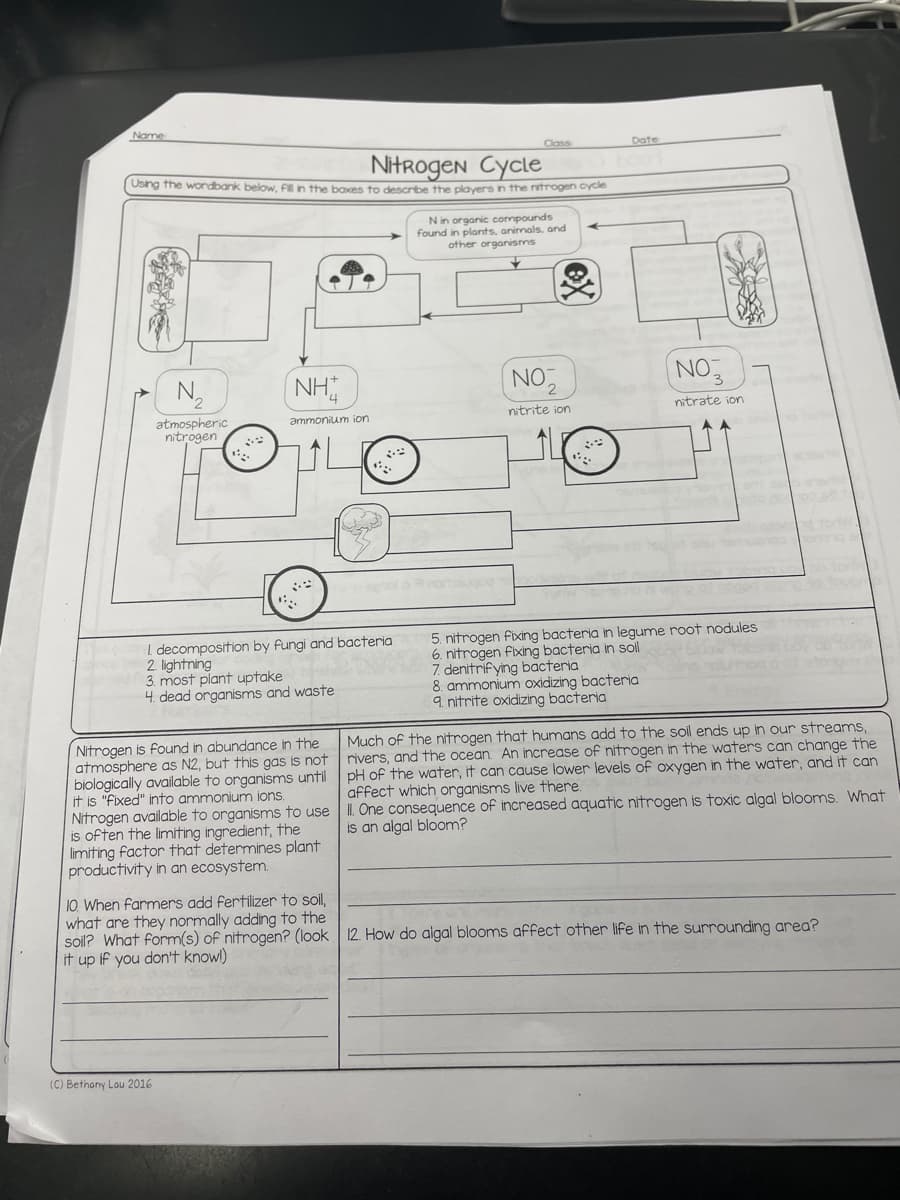Nitrogen Cycle Using the wordbank below, fill in the boxes to describe the players in the nitrogen cycle N₂ atmospheric nitrogen 2 NH mony Lou 2016 ammonium ion GA I decomposition by fungi and bacteria 2. lightning 3. most plant uptake 4. dead organisms and waste trogen is found in abundance in the mosphere as N2, but this gas is not ologically available to organisms until is "fixed" into ammonium ions. rogen available to organisms to use often the limiting ingredient, the iting factor that determines plant oductivity in an ecosystem. N in organic compounds found in plants, animals, and other organisms NO2 nitrite ion NO3 nitrate ion A 5. nitrogen fixing bacteria in legume root nodules 6. nitrogen fixing bacteria in soll ON THE 7. denitrifying bacteria 8. ammonium oxidizing bacteria 9 nitrite oxidizing bacteria Much of the nitrogen that humans add to the soil ends up in our stream rivers, and the ocean An increase of nitrogen in the waters can change pH of the water, it can cause lower levels of oxygen in the water, and it affect which organisms live there. II. One consequence of increased aquatic nitrogen is toxic algal blooms. is an algal bloom? When farmers add fertilizer to soil, at are they normally adding to the What form(s) of nitrogen? (look 12. How do algal blooms affect other life in the surrounding area? p if you don't know!)
Nitrogen Cycle Using the wordbank below, fill in the boxes to describe the players in the nitrogen cycle N₂ atmospheric nitrogen 2 NH mony Lou 2016 ammonium ion GA I decomposition by fungi and bacteria 2. lightning 3. most plant uptake 4. dead organisms and waste trogen is found in abundance in the mosphere as N2, but this gas is not ologically available to organisms until is "fixed" into ammonium ions. rogen available to organisms to use often the limiting ingredient, the iting factor that determines plant oductivity in an ecosystem. N in organic compounds found in plants, animals, and other organisms NO2 nitrite ion NO3 nitrate ion A 5. nitrogen fixing bacteria in legume root nodules 6. nitrogen fixing bacteria in soll ON THE 7. denitrifying bacteria 8. ammonium oxidizing bacteria 9 nitrite oxidizing bacteria Much of the nitrogen that humans add to the soil ends up in our stream rivers, and the ocean An increase of nitrogen in the waters can change pH of the water, it can cause lower levels of oxygen in the water, and it affect which organisms live there. II. One consequence of increased aquatic nitrogen is toxic algal blooms. is an algal bloom? When farmers add fertilizer to soil, at are they normally adding to the What form(s) of nitrogen? (look 12. How do algal blooms affect other life in the surrounding area? p if you don't know!)
Biology 2e
2nd Edition
ISBN:9781947172517
Author:Matthew Douglas, Jung Choi, Mary Ann Clark
Publisher:Matthew Douglas, Jung Choi, Mary Ann Clark
Chapter46: Ecosystems
Section: Chapter Questions
Problem 3VCQ: Figure 46.17 Which of the following statements about the nitrogen cycle is false? Ammonification...
Related questions
Question
100%
Can anyone please help me?

Transcribed Image Text:Name
Nitrogen Cycle
Using the wordbank below, fill in the boxes to describe the players in the nitrogen cycle
N₂
atmospheric
nitrogen
NH
ammonium ion
(C) Bethany Lou 2016
4.
I decomposition by fungi and bacteria
2. lightning
S
3. most plant uptake
4. dead organisms and waste
Nitrogen is found in abundance in the
atmosphere as N2, but this gas is not
biologically available to organisms until
it is "fixed" into ammonium ions.
Nitrogen available to organisms to use
is often the limiting ingredient, the
limiting factor that determines plant
productivity in an ecosystem.
Class
N in organic compounds
found in plants, animals, and
other organisms
NO,
2
nitrite ion
WA
Date
NO3
nitrate ion
5. nitrogen fixing bacteria in legume root nodules
6. nitrogen fixing bacteria in soll
7. denitrifying bacteria
8. ammonium oxidizing bacteria
9. nitrite oxidizing bacteria
Much of the nitrogen that humans add to the soil ends up in our streams,
rivers, and the ocean. An increase of nitrogen in the waters can change the
pH of the water, it can cause lower levels of oxygen in the water, and it can
affect which organisms live there.
II. One consequence of increased aquatic nitrogen is toxic algal blooms. What
is an algal bloom?
10. When farmers add fertilizer to soil,
what are they normally adding to the
soil? What form(s) of nitrogen? (look 12. How do algal blooms affect other life in the surrounding area?
it up if you don't know!)
Expert Solution
This question has been solved!
Explore an expertly crafted, step-by-step solution for a thorough understanding of key concepts.
This is a popular solution!
Trending now
This is a popular solution!
Step by step
Solved in 3 steps with 1 images

Knowledge Booster
Learn more about
Need a deep-dive on the concept behind this application? Look no further. Learn more about this topic, biology and related others by exploring similar questions and additional content below.Recommended textbooks for you

Biology 2e
Biology
ISBN:
9781947172517
Author:
Matthew Douglas, Jung Choi, Mary Ann Clark
Publisher:
OpenStax

Concepts of Biology
Biology
ISBN:
9781938168116
Author:
Samantha Fowler, Rebecca Roush, James Wise
Publisher:
OpenStax College

Biology: The Unity and Diversity of Life (MindTap…
Biology
ISBN:
9781337408332
Author:
Cecie Starr, Ralph Taggart, Christine Evers, Lisa Starr
Publisher:
Cengage Learning

Biology 2e
Biology
ISBN:
9781947172517
Author:
Matthew Douglas, Jung Choi, Mary Ann Clark
Publisher:
OpenStax

Concepts of Biology
Biology
ISBN:
9781938168116
Author:
Samantha Fowler, Rebecca Roush, James Wise
Publisher:
OpenStax College

Biology: The Unity and Diversity of Life (MindTap…
Biology
ISBN:
9781337408332
Author:
Cecie Starr, Ralph Taggart, Christine Evers, Lisa Starr
Publisher:
Cengage Learning

Biology: The Unity and Diversity of Life (MindTap…
Biology
ISBN:
9781305073951
Author:
Cecie Starr, Ralph Taggart, Christine Evers, Lisa Starr
Publisher:
Cengage Learning


Biology: The Dynamic Science (MindTap Course List)
Biology
ISBN:
9781305389892
Author:
Peter J. Russell, Paul E. Hertz, Beverly McMillan
Publisher:
Cengage Learning